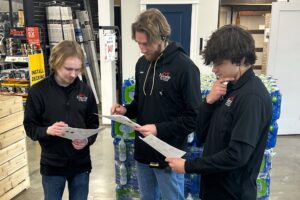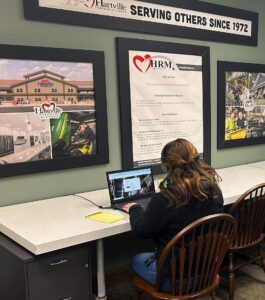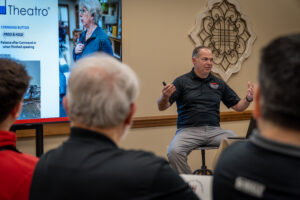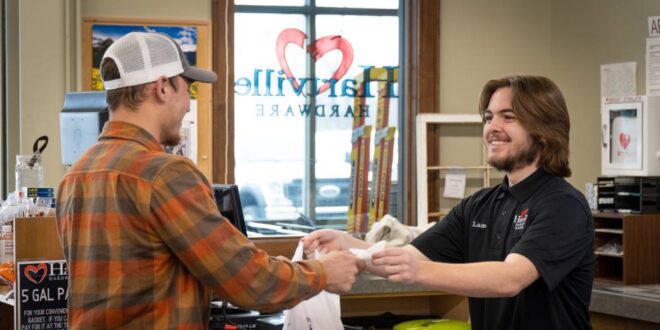This is one of a series of case studies into why training is important and the tangible results it can have on your business. Click here to read other case studies.
Of all the excuses for not training, “We’re just too busy” is one of the most common. Too often, however, retailers with that shortsighted view miss the long-term benefits of a formalized training program. Viewing training as an investment results in employees who are better prepared for their jobs and more versatile, even than some long-term staff.
An onboarding process at Hartville Hardware in Hartville, Ohio, immerses new employees in training for the first four weeks on the job. While the program is only a couple of years old, it has already been able to lay to rest some of the skepticism around sending a new hire to the training room for four hours in the day. New hires with proper training often had more knowledge in some areas than employees who had been there for years. Trained employees also boosted sales in categories that may have previously been weak.
“Managers are often the most reluctant to onboarding training because they are just looking for someone to help put out a fire,” says Chris Price, hardware division manager and part of the team that helped create the program. “But we’ve been able to show that employees with a few weeks of intentional training are better prepared and don’t require as much on-the-job instruction.”

The Challenge
Price started working at Hartville Hardware in 2008 as a sales associate in the paint department. As he worked his way up to department manager and eventually his current divisional position, he carried with him a passion for effective training.
“I discussed with our company leadership the idea that, if we want to be the best hardware store, we have to have the best training,” he says. “A few years later, they asked me to help develop a plan for every team member for the first four weeks on the job.”
When he helped roll out a new training initiative for Hartville Hardware in 2022, Price faced an obstacle likely common to many retailers. Managers claimed they were too busy to take a new hire off the floor to train; they needed someone to fill a spot right away.
 The Solution
The Solution
Hartville Hardware’s 305,000-square-foot flagship store is in Hartville, Ohio. The company also operates a contractor supply store, an e-commerce fulfillment center and a smaller hardware store in Middlefield, Ohio, and late last year acquired Coshocton Lumber in Coschocton, Ohio. Price, alongside HR manager Jen More and training coordinator Alison Wolshlager, led the creation of a four-week onboarding process where every new employee spends more than 40% of their time in some type of training. Wolshlager is the dedicated training coordinator whose job it is to make sure the company’s more than 500 employees get the correct onboarding and ongoing training.

The four-week onboarding plan includes online product knowledge training from the North American Hardware and Paint Association (NHPA) and vendor training for specific categories, where applicable. The first couple of days of training typically include a meeting with company leadership, paperwork and general orientation to the company. In addition to meeting their manager and other employees they’ll be working with directly, the new employee also has a chance to understand the interplay between their new position and other people in the company. For example, a new hire might meet the buyer responsible for their department so they understand how a buyer’s role connects to the sales associate’s role. Or, a buyer might spend time with the receiving department to understand how the two areas relate to each other.
Regardless of what an individual retailer’s onboarding process may look like, it’s important that it be intentional. Have a plan for how you’ll train and be ready to welcome the new hire. Don’t let them feel like an afterthought or that they’re getting in the way of regular business.
“As our company president has said, ‘We need to act like we knew this hire was coming,’” says Price. “In the past when a new employee showed up, we might have just done a lot of on-the-job shadowing and training, but now we’re being more intentional with specific classes and training they will need.”
For example, every new employee takes an in-person class called the Culture of Care, where Price explains the most important characteristics of being a Hartville Hardware team member. There is also a Sales 101 class for anyone coming into a sales position. Price recruits department managers to lead the variety of in-person classes they offer so new employees can meet managers throughout the store, which helps them understand who they can go to for help.

Another unique aspect of orientation at Hartville Hardware is the scavenger hunt, created by Wolshlager. New employees get a list of items to locate and questions to answer that will take them throughout the store.
“The questions on the scavenger hunt are intentional so they find certain departments to learn where items are located in the store and learn about all of the services we have. It’s a great way to expose them to the different aspects of the business.” Price says. “Alison sends out the plan for the scavenger hunt in advance to the managers for feedback and tweaks it accordingly so it meets the needs of the department where they’ll be working.”
After onboarding, employees are assigned supplemental training as needed, which might amount to between 4 and 6 hours per month per employee, depending on the job and the season. For example, all employees get recurring training on safety and on the store’s emergency action plan. Price works with Wolshlager to create micro-trainings to update employees on changes in store policy or other topics as needed.
Whether they are directing employees to train on the LMS or sending them to an in-person class, Price says one key to success is learning to use the resources you have. You don’t need a large budget to have an effective training program.
“Even if you’re a small store and you think you can’t afford a dedicated training person, you could still leverage key leaders who have the skills to train others,” he says. “If you’re intentional with training, you can go a long way with it.”

Using online materials such as those provided by NHPA makes course administration easy; all students need is a laptop or mobile device to take the training. Vendor training is another easy, and often free, way for retailers to make their employees experts in a particular product line. Vendors already understand that the more training and focus they can offer on their product, the better it’s going to sell.
For in-person training, spreading the instructional responsibilities among several people not only makes training more manageable, but also it allows new hires to meet multiple people in the business. Having a single person coordinate all of the training helps with organization and accountability.
“Find someone who is passionate about training and has the ability to train others, then give them some freedom to run with it and use their creativity,” Price says.
The Results
With a consistent onboarding process now a part of the company culture, staff who may have initially been skeptical about training are beginning to see its results and change their mindset.

“When we first started our onboarding program, everyone said they were too busy to take people off the floor and send them to a class,” says Price. “You have to bring your team to understand that the more prepared your team is, the more effective they’ll be. You have to play to the long-term investment instead of the short-term fix. Managers would tell me, ‘You want to take my new hire for four weeks of training? That’s crazy, we need them now!’ We had to get the managers to buy-in to our program before we could get it to work. It took a bit of a culture change to say we’re committed to preparing people, because the person you are going to get at the end will be better prepared than if you just threw them on the salesfloor on day one.”
In the end, Price says showing the tangible results of training created buy-in among existing employees.
“We did have some people who were initially struggling to see the benefits of training. We won them over by showing them the results,” he says. “We began having people we hired just a few months ago already better prepared to do their job than some who had been here a long time.”
Price can also draw a link between training and the success of a department. If there is a product line or area of the store that is weak, lack of training is often a contributing factor. Price remembers, for example, when he was working in the paint department, there were some product lines that were struggling. When he and his team focused in and trained on those areas, they saw noticeable increase in sales.
“Many times, if there’s an item that’s not selling like you think it should, it’s probably a lack of understanding or confidence in the product,” he says. “People don’t understand how to sell it.”
To any retailer questioning whether or not training is worth the time, it’s important to consider the alternative.
“There’s a little quote I heard from another local business,” Price says. “The business owner said, ‘You can invest in your people and they leave or you can not invest in your people and they stay.’ Have we invested in people that have left? Yes, and that’s frustrating. But you can do nothing and they will stay exactly as they are. The investment in your people will always pay off in the end.”
 Hardware Retailing The Industry's Source for Insights and Information
Hardware Retailing The Industry's Source for Insights and Information






